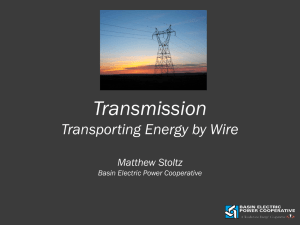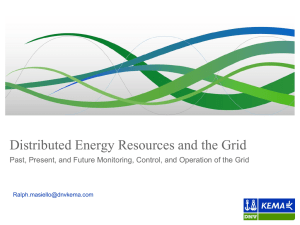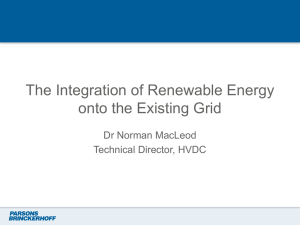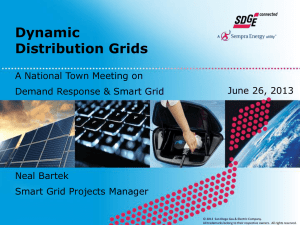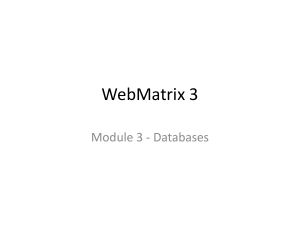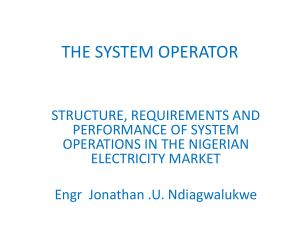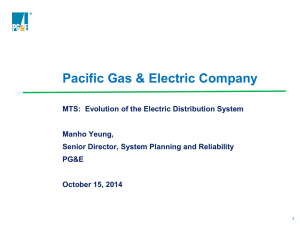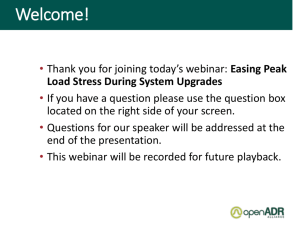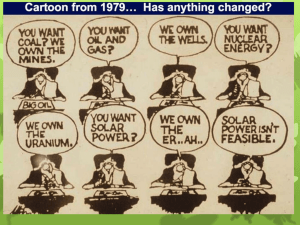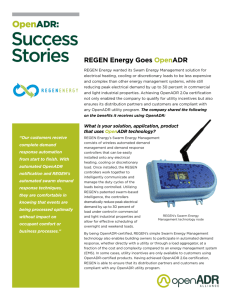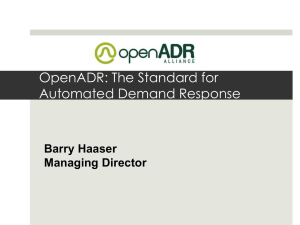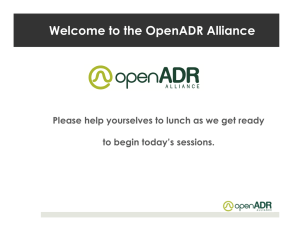Grid Integration Group
advertisement
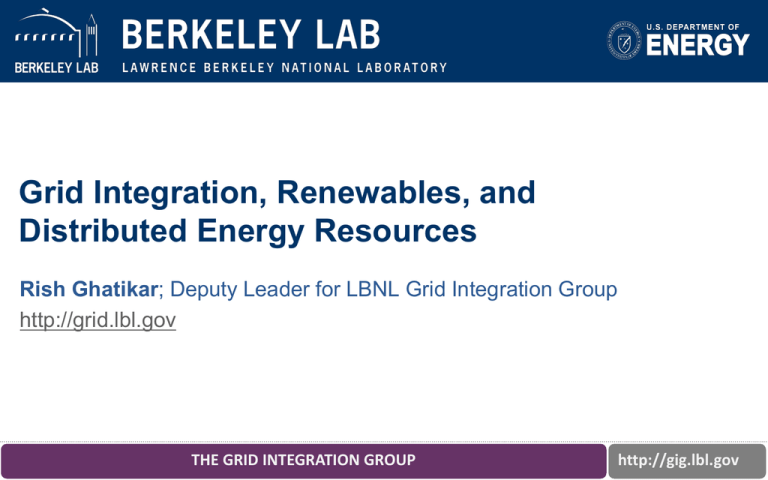
Grid Integration, Renewables, and Distributed Energy Resources Rish Ghatikar; Deputy Leader for LBNL Grid Integration Group http://grid.lbl.gov THE GRID INTEGRATION GROUP http://gig.lbl.gov Grid Integration Objectives The electric grid, end-uses, renewables, and electrical vehicle fleets represents key efficiency and energy security objective. The Grid Integration Group conducts, develops, and demonstrates strategies and technologies to transform, coordinate, innovate, and integrate distributed energy resources and markets. 1. 2. Dynamic interaction between grid operators and energy consumers Support the grid integration of intermittent renewable sources, electric vehicles Demand Response (DR) • • • • • Energy Technology & Systems Integration Tariffs, Measurement & Verification Communications and Telemetry Commercial, Industrial and Residential End Uses, Automation, Control, and Modeling Open, Automated DR (OpenADR) Microgrids • • • • Optimization of Distributed Energy Resources Distributed Energy Resources, Technologies, and Integration V2G, Vehicle to Building (V2B), Microgrids Distributed Energy Resources Modeling THE GRID INTEGRATION GROUP Electricity Reliability • • • • • Real-Time Grid Reliability Management Customers & Markets Renewable Integration Load as a Resource (LAAR) Reliability Technology Issues & Needs Assessment 1 Grid Integration and Technology Innovation1 Applied Research and Development Technology Demonstration and Deployment Market Facilitation 1. IEC Publicly Available Specification OpenADR specification (v1.0) by LBNL* Research initiated by LBNL/ CEC 2. U.S. SGIP Catalog of Standards 1. DR 2.0 Pilots and field trials - Wholesale markets, ancillary services - Dynamic pricing, renewable, EVs - International pilots (e.g., Europe, Asia) OpenADR 1.0 Commercialization 2. All end-uses and sectors Pilots/field trials 2002 to 2006 - IEC/PAS 62746-10-1 ed1.0 2007 2008 2009 2010 2011 2012 2013 2014 OASIS EI 1.0 standards 1. OpenADR Standards Development** - OASIS (EI TC), UCA, IEC 2. NIST Smart Grid, PAP 09, 19 1 The Electric Program Investment Charge (EPIC) Energy Innovation Pipeline * OpenADR v1.0: http://openadr.lbl.gov/ ** Publication: http://drrc.lbl.gov/sites/drrc.lbl.gov/files/LBNL-5273E.pdf ** OpenADR v2.0 standards: http://www.openadr.org/specification - OpenADR profiles 1. OpenADR 2.0 deployment - International standardization (IEC) 2. USGBC national pilots 3. Codes (CA T24) 4. Transition plans 1. Adoption (100+ members) 2. Test/Certification (OpenADR 2.0***) THE GRID INTEGRATION GROUP 2 OpenADR and Interfaces with End-Uses Enables California electricity providers to communicate targeted grid-services to customers using non-proprietary and open standardized interfaces using a common language and existing communications (e.g., Internet). Developed to meet CEC DR automation goals Low cost automation, technology for two-way secure communications, and controls integration Pricing, Reliability Data Models Server $/kWh, kW Data Model Control Strategies Physical Communications OpenADR Comm. Internet Protocol THE GRID INTEGRATION GROUP Client AutoDR EndUses Facility Actions 3 Clean Energy Generation • Requires California utilities (IOUs and Municipal Utilities) to generate 33% of electricity from renewables by 2020 – – – 4GW of ancillary services for grid stability Thermal generation : fossil fuel, high costs Energy storage mandate (1.3 GW by 2020) Flexible and responsive loads can play an important role in ramping services International Experience: Denmark goal is 50% by 2020, plans for 100% in 2050 THE GRID INTEGRATION GROUP 4 Linking Grid with Customer-Side Distributed Resources Distribution Grid, Operations, Market, and Provider Challenges: 1. 2. 3. 4. Large and variable generation, decentralized energy resources(roof-top PVs, on-site and co-gen) Diversity of electricity markets, technology, and services Cost, cyber security, metering, communications interoperability New options: storage, EVs Customer Challenges: 1. 2. 3. 4. THE GRID INTEGRATION GROUP Different brand of equipment, distributed energy resources Ease of adoption and cost effectiveness Grid services requirements Optimized use of DER (e.g., Microgrids) 5 Evolution of a Decentralized Energy Ecosystem • Electricity System is evolving from a centrally planned generation to a decentralized energy eco system – At various levels: demand, distribution, and transmission NIST Framework and Roadmap for Smart Grid DRAFT NIST Framework and Roadmap for Smart Interoperability Standards, Release 2.0 Grid Interoperability Standards, Release 3.0 THE GRID INTEGRATION GROUP 6 DR Automation and Renewable Integration • Market transformation towards a clean energy system and load flexibility Challenges with high renewable generation: • – Intra-hour variability, fast ramping (up/down), over generation and forecast errors Cost-effective flexible loads (costs only ~7% to 14% of gridscale storage*) Research Potential: • Identify potential issues with high penetration of renewables • Assess technologies (storage, generation, and DR, and their costs) • Consider interoperability standards and integration with DER (commercial, residential, industrial) * http://drrc.lbl.gov/sites/all/files/LBNL-5555E.pdf THE GRID INTEGRATION GROUP 7 Contact Rish Ghatikar – Deputy Leader; The Grid Integration Group; Lawrence Berkeley National Laboratory – Vice Chairman; The OpenADR Alliance – GGhatikar@lbl.gov Web References: • http://www.lbl.gov/ • http://gig.lbl.gov/ – – – • http://der.lbl.gov/ http://drrc.lbl.gov/ http://certs.lbl.gov http://www.openadr.org/ THE GRID INTEGRATION GROUP 8 BACK-UP SLIDES THE GRID INTEGRATION GROUP 9 Products and Loads for Fast DR Current products don’t fully address the ambitious renewable generation goals for 2020 and beyond Products Product Type General Description Response Speed Regulation Response to random unscheduled deviations in scheduled net load (bidirectional) Additional loadfollowing reserve for large unforecasted wind/solar ramps (bidirectional) Rapid and immediate response to a loss in supply Shed or shift energy consumption over time Ability to serve as an alternative to generation 30 seconds Flexibility Contingency Energy Capacity Physical Requirements Time to Length of How often fully response called respond Energy 5 Continuous neutral in minutes within 15 specified bid minutes period Participation of end-uses in Fast DR service products (shading colors identify resources that contribute to the same set of products) Products End-Uses Regulation Flexibility Agri. Pumping 5 minutes 1 minute 5 minutes 1 hour ≤ 30 minutes ≥ 1 hour 20 minutes ≤ 10 minutes 10 minutes Continuous within specified bid period ≤ Once per day 1-2 times per day with 4-8 hour notification Top 20 hours coincident with balancing authority area system peak Comm. Cooling Contingency Energ y Capacit y Comm. Heating Comm. Vent Comm. Lights Res. Heating Res. Cooling Refrigerated Warehouses Municipal Pumping Wastewater Pumping Data Centres THE GRID INTEGRATION GROUP 10
